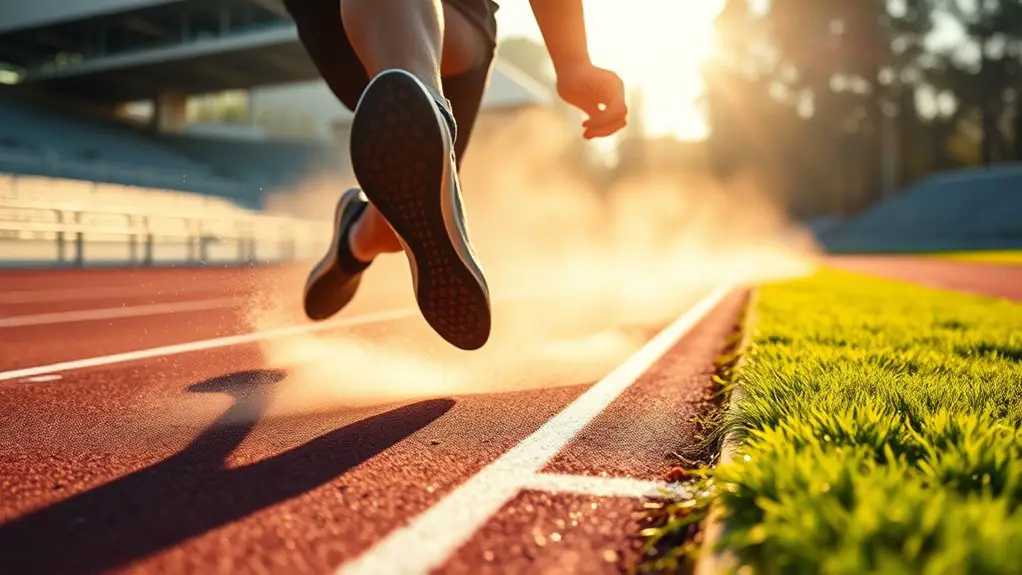To optimize flexibility and mobility for sport-specific movements, incorporate dynamic stretching and tailored mobility drills into your routine. Dynamic stretches like leg swings or high knees help prepare your muscles and elevate your heart rate. Perform sport-specific mobility drills—like hip openers for soccer or ankle drills for basketball—to enhance performance. Don't forget consistency with flexibility training, combining both static and dynamic stretches. Keep going to discover more effective strategies to boost your athletic performance.
Understanding Flexibility and Mobility in Sports
When it comes to sports performance, understanding the difference between flexibility and mobility is crucial. Flexibility refers to your muscles' ability to lengthen, while mobility involves the freedom of movement in your joints. Both are essential for peak performance and can greatly impact your range improvement.
Static stretching is a common method to enhance flexibility, allowing your muscles to relax and lengthen gradually. Incorporating static stretching into your routine can help you achieve greater flexibility, making it easier to perform movements without restriction. However, remember that flexibility alone won't guarantee fluid motion; you also need to focus on mobility. Additionally, mobility training serves as a foundation for strength and endurance, further enhancing your overall athletic performance.
Dynamic Stretching Techniques for Enhanced Performance
To maximize your athletic potential, incorporating dynamic stretching techniques can greatly enhance your performance. Dynamic warm-ups elevate your heart rate and prepare your muscles for movement, allowing you to move freely and efficiently. Unlike static stretching, which can temporarily reduce muscle strength, dynamic stretches activate your entire body, increasing range of motion and reducing injury risk. Additionally, engaging in dynamic stretching can contribute to long-term athletic success by preparing the body for more intense workouts.
Here's a quick overview of effective dynamic stretching techniques:
| Dynamic Stretch | Benefits |
|---|---|
| Leg Swings | Improves hip flexibility |
| Arm Circles | Enhances shoulder mobility |
| Walking Lunges | Activates lower body muscles |
| High Knees | Engages core and legs |
Incorporate these techniques into your routine before workouts or competitions. By doing so, you'll not only feel liberated in your movements but also optimize your performance on the field or court. Remember, a well-prepared athlete is a successful one!
Targeted Mobility Drills for Specific Sports
While optimizing flexibility is essential for all athletes, specific sports require targeted mobility drills to enhance performance in unique movements and positions. To achieve this, start with mobility assessments that identify your strengths and weaknesses. For example, if you're a soccer player, incorporate hip openers and dynamic lunges to improve your range of motion for kicking and sprinting. Basketball players benefit from ankle mobility drills, allowing for quicker lateral movements and better stability.
If you're into weightlifting, focus on shoulder and thoracic spine mobilization to guarantee proper form during lifts. Additionally, incorporating dynamic stretching into your warm-up routine can significantly enhance muscle performance and reduce the risk of injuries. Tailoring your sport-specific drills not only boosts performance but also reduces the risk of injury. Remember, it's all about creating freedom in your movements, so don't shy away from experimenting with various drills to find what works best for you. Embrace the journey, and your body will thank you!
Incorporating Flexibility Training Into Your Routine
Building on the targeted mobility drills discussed earlier, incorporating flexibility training into your routine can markedly enhance overall athletic performance and recovery. By embracing flexibility benefits, you'll increase your range of motion, reduce injury risk, and improve muscle efficiency. To truly reap these rewards, aim for a consistent training frequency—ideally, dedicate time to flexibility exercises multiple times a week.
Start with dynamic stretches before workouts to prepare your muscles and end with static stretches to promote recovery. You might find yoga or Pilates particularly enjoyable, as they not only improve flexibility but also enhance your mind-body connection. Remember, the goal is to feel free and unrestricted in your movements, so choose techniques you love. Consistency is key; making these practices a regular part of your routine will guarantee you're not just flexible but also capable of performing at your best when it counts. Additionally, prioritizing mobility training helps maintain joint health and improves body resilience, further enhancing your athletic potential.
Monitoring Progress and Adjusting Your Training Plan
How can you guarantee your training remains effective and aligned with your goals? Monitoring progress and making training adjustments is key to staying on track. Regularly evaluating your flexibility and mobility will help you identify what's working and what needs tweaking. Here are some ways to keep your training on point:
- Keep a training journal to note your flexibility gains.
- Use video analysis to assess your movement quality.
- Set specific, measurable goals to guide your focus.
- Incorporate regular assessments to measure your progress.
- Be open to changing your routine when you hit plateaus.
- Engage in Functional Movement Screening to pinpoint movement dysfunctions that may hinder your progress.
Frequently Asked Questions
How Does Age Affect Flexibility and Mobility in Athletes?
As you age, you might notice some changes creeping in, especially when it comes to flexibility and mobility. Youth athletes often enjoy a natural range of motion, but the aging process can tighten those once-loose joints and muscles. You may find it harder to execute those fluid movements you used to, but don't despair! With the right approach, you can still reclaim that freedom and enhance your athletic performance, no matter your age.
Can Nutrition Impact Flexibility and Mobility Performance?
Absolutely, nutrition can greatly impact your flexibility and mobility performance. By focusing on nutrient timing, you can make certain your body gets the right fuel when it needs it most. Incorporating anti-inflammatory foods, like berries and fatty fish, helps reduce inflammation and improve recovery, allowing you to move more freely. So, if you want to release your full potential, consider how what you eat plays an essential role in your performance and overall mobility.
What Role Does Hydration Play in Mobility Training?
You might not realize how essential hydration is until you feel that first cramp. Maintaining fluid balance is important; without it, your mobility training can suffer. Think about hydration techniques like sipping water consistently rather than chugging it all at once. When you're well-hydrated, your muscles can stretch further and recover faster, giving you the freedom to move without limitations. So, keep that water bottle close—you'll thank yourself later!
Are There Specific Supplements for Improving Flexibility?
When you're looking to improve flexibility, certain flexibility supplements and mobility enhancers can help. Ingredients like glucosamine, chondroitin, and collagen support joint health, while magnesium can relax muscles. Omega-3 fatty acids may also reduce inflammation, aiding in better movement. Just remember, while these supplements can assist, they work best alongside a balanced diet and a solid stretching routine. Embrace your journey to greater freedom of movement and enjoy the benefits!
How Does Sleep Influence Recovery and Flexibility?
You might think you can push through on little sleep, but that'll only hold you back. Quality sleep is essential for effective recovery techniques. When you rest well, your body repairs itself, improving flexibility and reducing stiffness. So, instead of burning the midnight oil, focus on getting restorative sleep. It's the foundation for athletic freedom, allowing you to move with more ease and confidence. Prioritize your sleep, and watch your performance soar!




